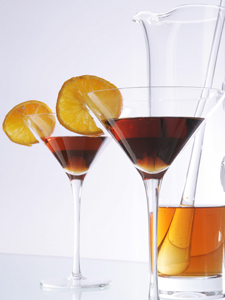Avoiding Alcohol? Drink Tea Instead

You're at a party, and it's 5 o'clock somewhere. Joe Bro offers you a cold one.
Here it comes.
You brace yourself, collecting the series of responses geared to mitigate the impending situation: personal preference, health, history, religion, etc. For Joe Bro, "No thanks, I don't drink" isn't enough without explanations that sound legit.
Then you look down at the cup in your hand.
Oh, wait.
You don't have to go through that anymore. You have tea.
Whether aged fruits and grains, or aged Camellia sinensis leaves—it's all plant matter. Both have been oxidized or fermented, and thanks to science and fortune, the similar methodology produces similar flavors. For every category of booze or brew, there's an equivalent tea.
Beer: Breakfast blacks.
A malty Assam or Kenyan black tea can be as robust as any brewski. The key is concentration—the ratio of leaf to water—and a fair hand at iced tea.
To get beer's belly-filling body, use 2.5 times as much tea as you would for a hot cup, and half the usual amount of water. Let's say that your regular black tea is 1 teaspoon per 8 ounces of boiling water. This means that your beer-tea would need 2.5 teaspoons of leaf, steeped in 4 ounces of water at a rollicking 212 degrees Fahrenheit (95 degrees Celsius).
If you like a strong brew, then you have the freedom to do a longer steep than usual. Less water in the cup means that it'll cool down faster, so that your tea will be less likely to go bitter. If you time it right, then a touch of bitterness will even mimic beer's astringent aftertaste.
Once you've done your steep, then take the leaves out. For single drinks, a basket infuser is best for maneuverability. When serving multiple non-drinkers, you can adapt with a teapot or gravity steeper like the IngenuiTEA, and double or triple the recipe depending on how many thirsty folks are in line. (Be warned: if someone tastes your cup, then you may end up making multiples anyway.)
Finish off the drink by filling the rest of the cup with ice. The smaller the cubes, the better, as the hot tea melts them into chuggability.
Wine: Fruity blacks.
Strut your Darjeelings and Ceylons. These South Asian teas are full of raisin notes that wine connoisseurs will recognize as "muscatel."
To prepare a cold wine tea, simply use the beer recipe above and add iced grape or cranberry juice at the end.
For hot mulled wine—we're still in winter, after all—add 1 teaspoon of masala chai or your favorite sweet spices to the infusion and follow the rest of the above steps, then reheat your cup to taste. 2 minutes in the microwave should do it, or 5 minutes on the stovetop if you're going the traditional route. (Please don't do your first infusion on the stovetop! Boiled tea leaves are wicked bitter and release twice as much caffeine as a regular steep. Keep in mind that tea was originally boiled in ancient China for medicinal purposes.)
Liquor: Sheng Pu-Erh.
Not only does a raw, green Pu-Erh taste like high-quality whiskey, it has the same kick on the aftertaste. Young Pu-Erhs, from trees 40-50 years old, are especially prone to that alcoholic "bite." If you're lucky enough to procure an older one—from a tree that's been around for at least a century—then the flavor will be richer and mellower, with more pronounced differences between steeps.
Also like liquor, Pu-Erh is best served in shots. Enter the gaiwan, a small Chinese teapot used for gongfu tea ceremonies. With upwards of 3 teaspoons per 6-ounce pot, you and your friends can enjoy quick, 30-second to 2-minute steeps for rounds of tiny cups soaked in flavor. The short infusion makes Pu-Erh the easiest and quickest way to not-drink while drinking.
If you don't have a gaiwan, it's fine. Do gongfu-style shots with a gravity steeper or small Western pot. Just make sure that the leaves have enough room to expand to their fullest—this will usually happen after the first few steeps—and that the leaves don't continue to steep between rounds, to preserve flavor.
However, it's difficult to translate gongfu into a cold drink, as adding ice cubes slow down the fun of rapidfire.
But for an iced beverage that will last you through awkward small-talks and watching Joe Bro play beer pong, use the beer recipe and adjust the steep time and concentration to taste.
Cocktails: Herbals and flavored tea.
Now that you've got the basic recipes down for tea-mixology, you can apply it just as you would for your favorite mixed drink. Some ideas:
Play around with barside ingredients to put your own spin on the classics. For example, different milks—cow, goat, sheep, soy, almond, rice and coconut—each impart their own flavors, and can bring out certain characteristics of the tea that mirror real-life cocktails.
Thus, if you're using coconut milk for the faux White Russian, then it may turn out more like an infusion of coconut rum, which may instead lend itself better to a tropical drink.
Build on the recipes for the more complicated drinks, like Mai Tais and Butterbeer, which will require combining the premade tea recipes as a bartender would combine liquors and syrups. Take the extra prep time to develop your mixology style, but please be careful around the boiling water when you start table-dancing.
Bonus: tea can still give you a sense of intoxication. In Chinese, it's called "tea drunk," and refers to the mindful elation from a heady cup. We may otherwise know it as "the endorphin rush enhanced by beneficial stimulants l-theanine and caffeine."
Cheers.
